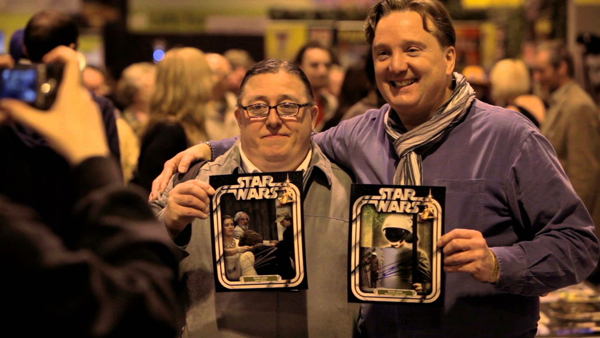Movie review by Greg Carlson
Jon Spira’s “Elstree 1976” rounds up a group of bit players, extras, and background performers who just happened to be part of “Star Wars” before anyone had a clue that the film would become a popular cultural juggernaut. In the North London studio location where many sets had been constructed, some of the actors labored under the impression they were working on a minor entertainment designed for television broadcast. Others, however, grasped the possibility that George Lucas was in fact the real deal. Built primarily for fans but nevertheless enjoyable for space fantasy agnostics, Spira’s documentary poses some interesting questions about the elusive and mercurial nature of fame and the serendipity of being in the right place at the right time.
For the most devoted “Star Wars” fanatic (and I count myself among their number), “Elstree 1976” makes a few unexpected moves in terms of structure and content. Dominated by talking head interviews, the movie spends as much time listening to the participants describe in detail their personal journeys in stage, screen, and show business as it does unpacking any new or juicy tidbits of information about the making of “Star Wars.” That turn toward the quotidian humanizes the ten subjects, but rabid devotees will hunger for more insider talk of what it was like to spend time in the Mos Eisley cantina or Yavin 4’s rebel hangar.
David Prowse, who wore Darth Vader’s helmet, swung his lightsaber, and spoke his dialogue on set under the impression that his voice would eventually be heard onscreen, is the best-known member of the “Star Wars” cast to appear in “Elstree 1976.” Spira spends plenty of time with Prowse, rehashing the one-time bodybuilder’s notable role in “A Clockwork Orange” before addressing the feud between Lucasfilm and Prowse that has resulted in bitterness and acrimony unusual at Prowse’s level of importance within the “Star Wars” family. I wish Spira had probed the matter more deeply.
I am not sure whether the staged reenactments of stormtroopers and X-wing pilots standing around with sandwiches or scratching at the crotches of itchy armor adds value to the movie, but one imagines that any independent, non-sanctioned examination of “Star Wars” has to come up with some creative strategies to get around the lack of access to actual behind-the-scenes footage. The frequent macro close-ups of action figures in the likenesses of characters portrayed by the interview subjects is more interesting, particularly because Spira turns his attention to the proliferation of appearances at fan conventions by even the most tenuously connected “Star Wars” employee.
To that end, another of the movie’s most intriguing rabbit holes considers the unspoken – and apparently often violated – code of honor among those who make money by selling autographs at cons. Spira alights on a curious rift that sees a hierarchical pecking order of the lower tier personnel determined partially by just how much a person needed to have done to be afforded status in the exclusive “Star Wars” club (spoken line of dialogue vs. silent, masked appearance is one dividing line, for example).
That so many extras were hidden under Imperial helmets has only complicated the assignation of credit. The recent death of Michael Leader inspired multiple online obituaries identifying him as the stormtrooper who accidentally bumps his head while crossing through a Death Star passageway. In “Elstree 1976,” however, it is actor Laurie Goode who claims to be the clumsy soldier. That at least two people have become associated with such a seemingly insignificant gaffe says much about our ongoing fascination with a galaxy far, far away.
